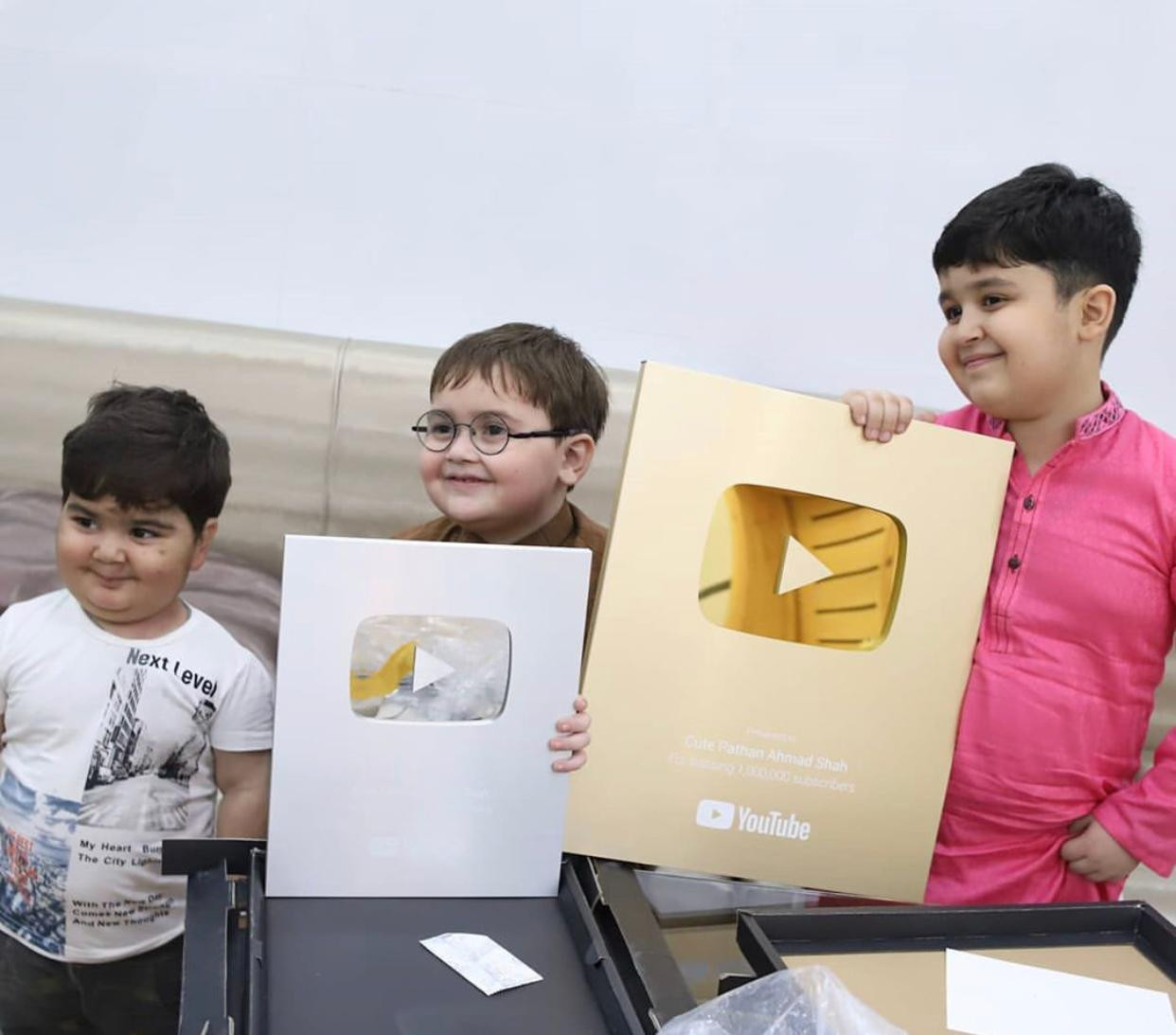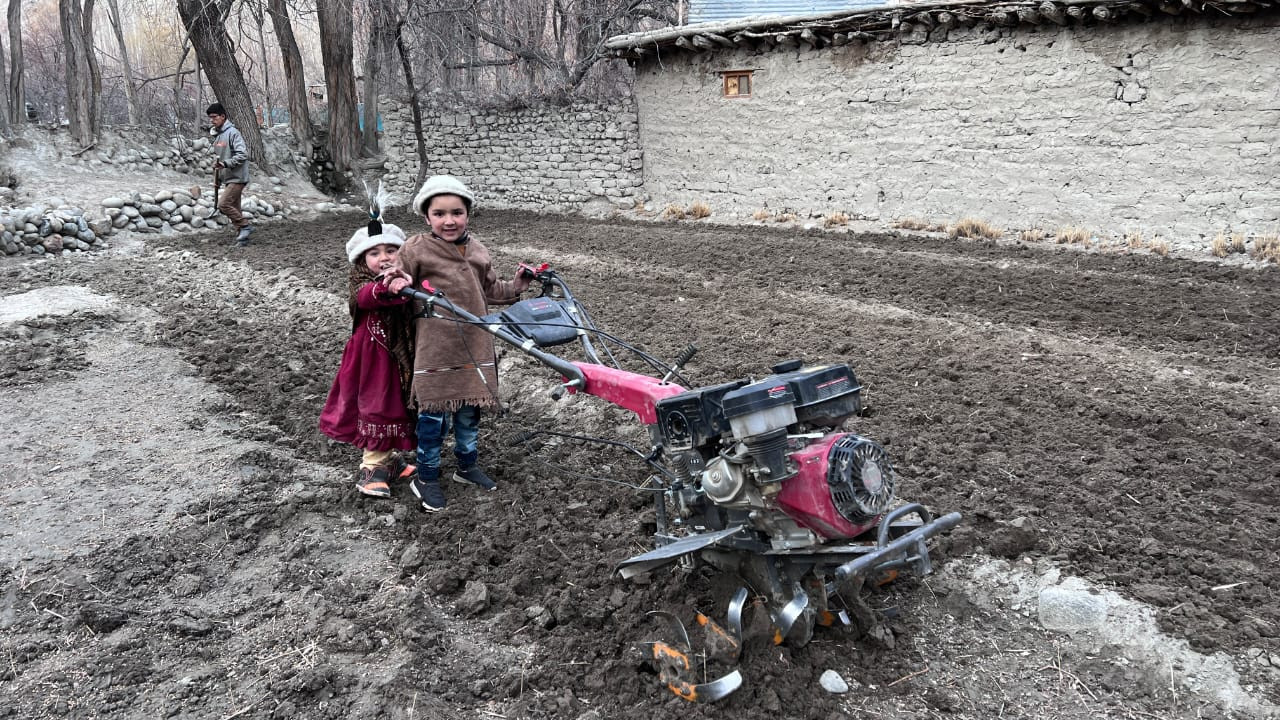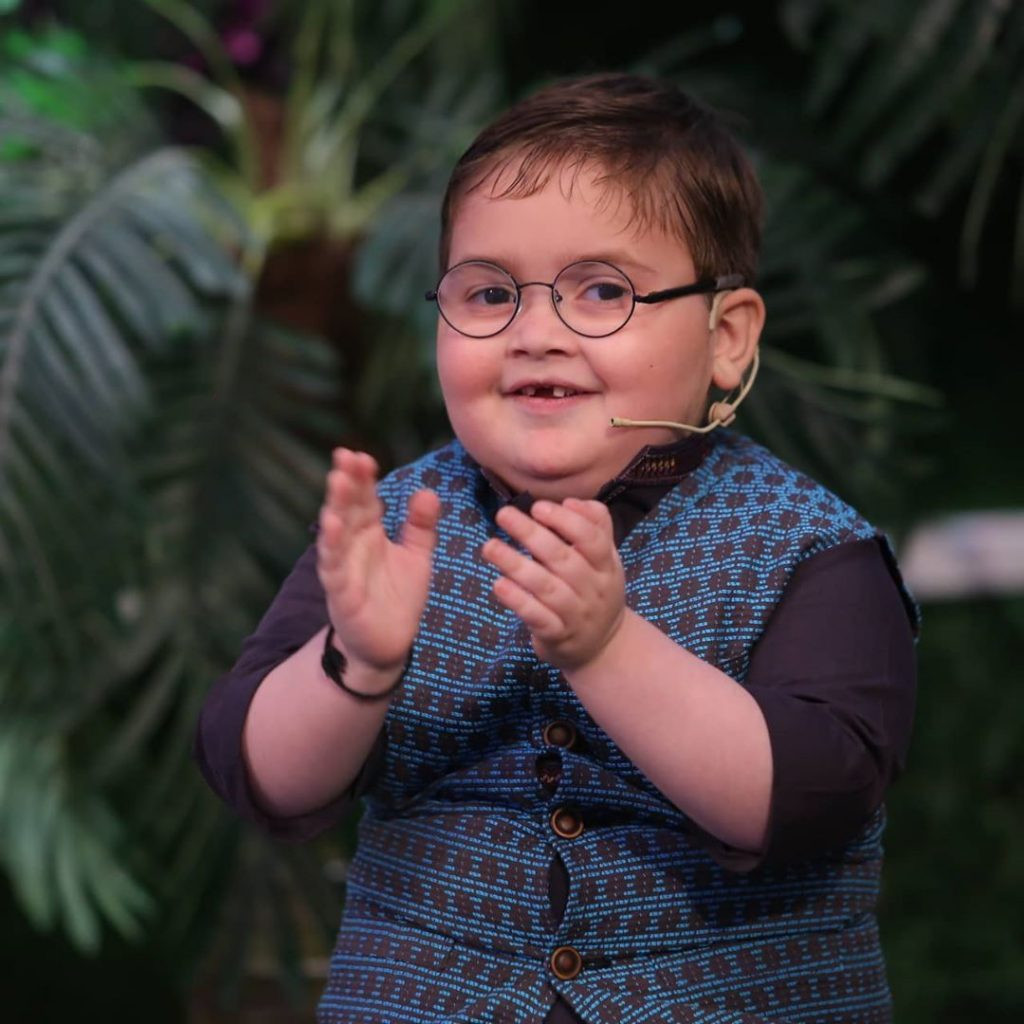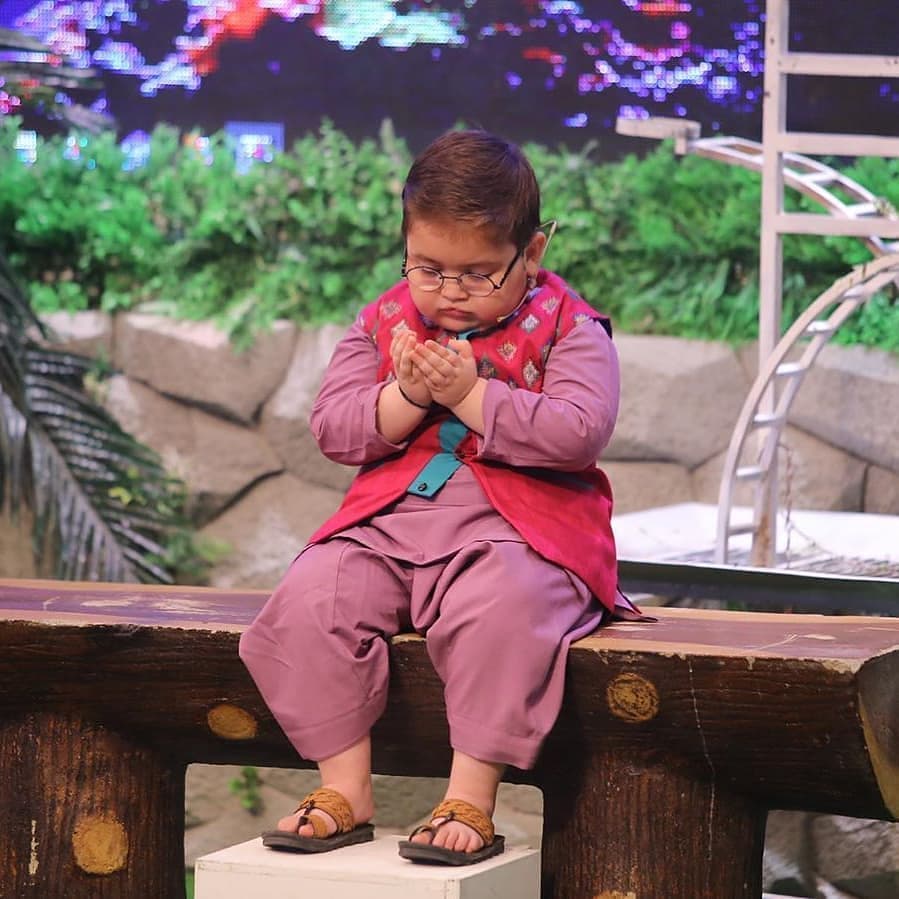Ramazan transmissions and the perils of childhood fame
The exploitation of innocence for commercial gain and the commodification of childhood itself
KARACHI:Have you ever pondered why urbanites find the seemingly brash and almost impolite antics of child star Ahmed Shah endearing, even laughable? And what is it about the Shirazi village vlogger siblings that elevate them to a status where both of them are now a central figure in Pakistan's most renowned Ramadan transmission?
Actor and host Mishi Khan was prompt to highlight their innocence as their distinctive selling point. She also criticised the practice of plucking children "from the mountains" and exploiting their innocence for commercial purposes by TV networks. While Mishi's sentiments resonate with those who reject this spiritual spectacle, her argument had gaps that prompted the transmission's host to step in with a daring yet strategic clarification.

"You cannot fathom the extent of our concern for these children and their welfare," Wasim Badami asserted. He continued, with Shah, Shiraz, and other child stars from his show perched on a swing in the backdrop, "I firmly believe in the principle of reciprocity. As a father myself, I wouldn't wish anything upon these children that I wouldn't wish upon my son. Believe me, the joy these kids experience on the show is palpable; sometimes they even arrive well in advance of their call time. It's akin to interacting with children at a family dinner."
The clarification was prompted by Mishi’s expressed concerns, yet it also brings to light a broader issue that has long afflicted the child star industry—a quandary concerning labor and the blurred lines between work and education, masquerading as play. It underscores a dual dilemma: the exploitation of innocence for commercial gain and the commodification of childhood itself.
Imposed cuteness1711351362-3/image-(486)1711351362-3.jpg)
Scholars in Star Studies and Child Development have found themselves at odds regarding the repercussions of exploiting children's innocence to fuel the media machine. Mengfei Pan and Yuqing point out a troubling trend where attention becomes synonymous with financial gain, exacerbating the challenge of exercising restraint over both fans and fame. What unites children thrust into the limelight, not for any particular talent like gymnastics or early mastery of complex math, but for their mannerisms, behavior, or mere existence, is the lens of adult scrutiny.
A five-year-old who is overweight for their age does not perceive himself or herself in terms of being a "cutie-pie" or a "munchkin." Instead, they identify with their totality, their complete being, which defines their sense of self. However, it is the adults who often impose labels of infantilism and cuteness upon them. Consequently, the concept of cuteness, especially concerning children, evolves into an aesthetic trope over which children wield minimal agency or power. The media industry picks on such kids, who go viral for existing the way they and expressing themselves, and turns it into an industry of mass cuteness.
Folk fodder for entertainment

Basharat Issa, an anthropologist hailing from Gilgit-Baltistan and a lecturer at Habib University's Comparative Humanities Program, extends the argument by emphasising the geographical origins of the children featured in these transmissions. He contends that the children showcased on these platforms predominantly hail from the peripheries of our country. Consequently, even the slightest nuances of their behavior are perceived as "entertainment" for urban audiences residing on the mainland.
Issa's perspective delves deeper into the socio-cultural and political dynamics at play. He suggests that the allure of these children stems not only from their innocence or perceived cuteness but also from the exoticisation of their identities as representatives of marginalised regions such as Gilgit-Baltistan. This phenomenon reinforces the narrative of urban superiority and exoticises the lives of those living in the peripheries, reducing their experiences to mere spectacles for urban consumption.
“I just hope people finding amusement in these videos and the media apparatus feeding off the same, look beyond his cute Balti accent and notice the impoverished conditions that the inhabitants of this village live in. I just hope that his fame and success don’t get restricted to being a mere spectacle of soft image and mass entertainment.”
Issa’s sentiments echo the fact that all these high-budget Ramazan transmissions take place in Karachi, which is Pakistan’s biggest urban center that owes its cultural and linguistic ‘dominance’ over the rest of Pakistan to North Indian Muslim families that immigrated to Pakistan and played a key role in shaping the voice and vocabulary of our media ecosystem. Hence crisp, often verbose use of Urdu language and diction is usually the standard these transmissions aspire to maintain, with a little bit of that sharp Arabic expression slid in by the host to ensure the ‘Islamic touch’ in Ramazan.
Artwork by Mohsin Alam
These children from the peripheries, in the case of Ahmed and Shiraz, from Gilgit-Baltistan, with their raw, unrefined, loud and almost folkish ethnic expression provide a huge contrast from the pitch-perfect, understated symphonic Urdu expression of these transmissions, resulting in a perfect imbalance, a comedy of errors that makes the audience crack up and the children beam with a false sense of achievement.
False because they have been rewarded by public appraisal for living the way they live albeit in a setting where their ‘naturalness’ is celebrated as cuteness by a media fraternity and audience that can never imagine their own kids, doing things that kids do, like biting a ball, beat a pillow, randomly laugh and giggle, and draw the same charm and following as Shiraz and Ahmed. Are we then really finding their lack of urban exposure cool or does everyone watching these kids, watches them with the sensitivity and consciousness of not just reducing them to objects of jest? What if one day these kids see things for what they are and choose to be a less cute, read laughable version of themselves?
What happens when we grow tired of them?
Fame, even in the best of cases, for people at the top of their game, can be a hard thing to retain. There is a reason why A-listers, from Hollywood to Bollywood, consciously reinvent themselves and why those in the B-list and below, become objects of ridicule if they cannot ‘gracefully’ fade into obscurity. When it comes to child stars, then, a big question is what happens when they lose our interest?
A fraction of this shock is something we all go through as we grow up. Things toddlers do that we find adorable become obnoxious when they become older. The same process repeats at every major stage of growth; pre-teen to teen, teen to adult. Young people, even without the pressures of fame, can struggle to understand why it’s suddenly wrong for them to behave in a manner they were loved for just a year ago. Imagine that while contending with the public glare.

In the West at least, recent years have seen the conversation around child stars shift as some of the biggest ones struggled transitioning to adult life. Take the case of Macaulay Culkin, the star of the blockbuster Home Alone movies of the nineties. The image of boyhood innocence that propelled him to global fame as a child made it difficult in his own words to transition to adult life. That feeling of being trapped kicked off a spiral of depression and substance abuse, a pattern repeated with many other similar child celebrities.
In the case of Gary Coleman, the star of American sitcom 80s American sitcom Diff’rent Strokes, post-fame would have tragic consequences. Like Culkin, Coleman too fell into depression and drug abuse. Trapped into his childlike appearance due a medical issue, the former star also reported being deeply humiliated by people asking: “Didn’t you used to be…?” when he was working as a security guard at a supermarket as an adult.
Even those most well adjusted after transition from childhood fame can suffer its scars. Speaking to Variety in 2019, one-time Disney Channel star Cole Sprouse highlighted the importance of anonymity, something most regular people take for granted. "One of the dangers … [is] you're raised in such an insular environment that you forget what real human experience… looks like… Anonymity is one of those things that allows you to enter into a human space with an open heart and really be able to move with more agency and learn about people and learn about their stories without these predetermined notions of yourself, being carried by other people," he said at the time.
Industry of exploitation

A series of high-profile revelations from former child stars have refocused attention on the exploitation they can face during the peak of their fame, both from strangers and family members. As Mohammad Shiraz's involvement in Ramazan programming sparks debate at home, a recent American documentary has refocused attention on the darker aspects of children's television, including the toxicity, psychological trauma and risks of sexual abuse young performers may encounter.
Jennette McCurdy, a former Nickelodeon star, has been among the most vocal in highlighting the risks of exploitation faced by child stars. "My whole childhood and adolescence were very exploited," she told The New York Times in an interview. "There were cases where people had the best intentions and maybe didn't know what they were doing. And also cases where they did - they knew exactly what they were doing,” she added.
In an opinion piece for People magazine, another former child star Alyson Stoner reflected that she ‘narrowly’ survived the ‘toddler-to-trainwreck pipeline’. "In fact, nothing was designed for me to end up normal. Stable. Alive."
Institutional safeguards

All this isn’t to say or allege that anyone necessarily harbours ulterior motives or ill will toward the likes of Ahmed Shah or now Mohammad Shiraz when they are invited to be part of a media circus. Let’s say we take someone like the anchor for his word and accept not only his concern for the kids’ well-being but believe he has taken every step possible to safeguard them from any harm.
Let’s set aside, for the time being, the perils of fame itself on these children. A prominent figure like the anchor of a mainstream media group can still be believed to have a vested interest in ensuring the children come to no harm at his or her hand. But what about third or fourth tier channels? What about spaces where there’s little incentive to be above board and transparent?
When we talk of child stars and their exploitation, we should demand institutional safeguards, regardless of the best intentions of certain individuals. We should require the media groups that bring these kids on board to meet a whole set of regulations; how long are these kids in a studio environment, is there a parent or guardian with them at all times, etc. Not to mention clear guidelines regarding the financial compensation and benefits these kids receive.
In countries like the US and UK, a registry of sex offenders is not only kept but made publically available. Any job that requires working with kids makes it incumbent on the employer to make sure candidates clear a background check. While abuse no doubt occurs even with such a system in place, at least it can provide one layer of security.
Regarding finances, there is a tendency to blame the parents of children like Shiraz and Shah. What critics tend to gloss over is that the money offered to such families may often represent a generational opportunity. Would you really refuse it if, in theory, it could improve the standards of living for all your children?
Perhaps what we should really ask is if the money these kids receive is proportional to the ‘value’ they bring to a media group’s programming. In isolation, a few hundred thousand rupees can appear a generous package, but is it really? When a single anchor draws millions of rupees for one month’s worth of transmission, what’s a few hundred thousand?
Once a child's family receives payment, there should perhaps be institutional safeguards in place to ensure that the child whose labour is exploited can benefit from it. Hollywood recognised this early on, leading to the passing of the Coogan Act in the US. Named after Jackie Coogan, Charlie Chaplin's co-star in ‘The Kid’, the law mandates that 15 percent of a child performer's earnings must be held in trust for them until they reach adulthood. As the story goes, Coogan realised when he reached adulthood that his parents had squandered every cent he earned.
Or maybe it is easier to not bring children into cynical cash grabs every year at all. Let them keep their innocence without being thrust into a world that they are too young to figure out, let alone navigate.
Have something to add ot the story? Share it in the comments below.

1711351430-0/image-(453)1711351430-0.webp)
COMMENTS
Comments are moderated and generally will be posted if they are on-topic and not abusive.
For more information, please see our Comments FAQ